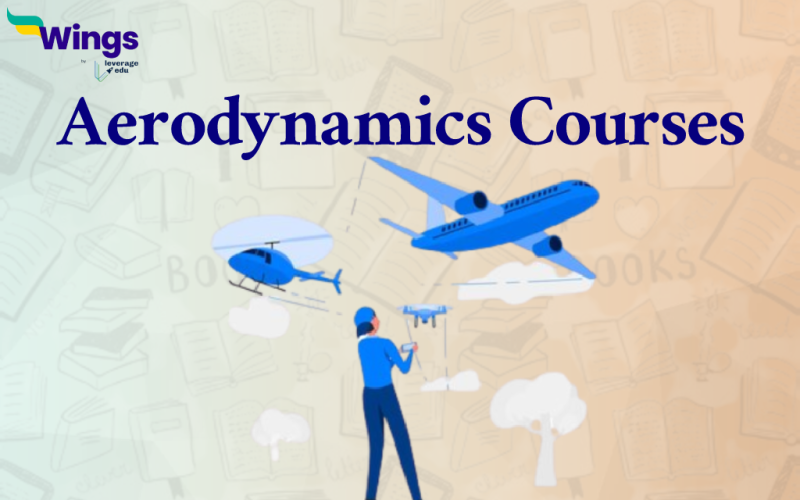The Aerodynamics course contains the study of the flow of air about a ‘body’. The body generally refers to an aircraft. However, the concepts explored are relevant to sailboats, automobiles, and birds as well. The course is best suited for mechanical engineers, Aerospace engineers, Avionics engineers, Aeronautical engineers, employees in the aerospace industry with no background, and space lovers. Those who complete the Aerodynamics course gain knowledge of concepts and models that are used to aerodynamically design subsonic, transonic, and supersonic aircraft. The aerodynamics course is usually a part of the undergraduate subjects under the aerospace engineering program. Keep reading to know more about the Aerodynamics courses, aerodynamics subjects, and its scope.
This Blog Includes:
Why Study Aerodynamics?
Students can opt for the aerodynamics course for the following reasons
- The course is both theoretical and practical and helps the students understand aerodynamics in a simple manner
- The student will learn everything related to the designing of commercial aircraft such as Boeing or Airbus.
- The increase in the use of applications such as drones, UAVs, micro air vehicles, and automobile aerodynamics has increased the scope of aerodynamics. Thus, it is important to know the fundamental concepts while working on these applications.
- The aerodynamics course is fully online and self-paced. Moreover, no prior information in the field is required to take the course.
Aerodynamics Syllabus
Below is the Aerodynamics course syllabus that is followed.
| S.No | Aerodynamics Subjects |
| 1 | Aircraft’s classification |
| 2 | Basics of aerodynamics |
| 3 | Basic fluid dynamics |
| 4 | Air compressibility effects and supersonic speeds |
| 5 | Viscous flows including laminar and turbulent boundary layers |
| 6 | Mach numbers, pressure coefficients and shock waves development |
| 7 | Transonic 3D wing design |
| 8 | Supercritical airfoil design |
| 9 | Lift and Drag estimation techniques |
| 10. | Aerodynamics software |
Also Read- Best Engineering Courses
Aerodynamics Eligibility Criteria
Anyone can apply online for the aerodynamics course at the university of their choice. Later, the department will take the decision to admit the student to the online course or not. However, the following eligibility criteria are required to study the aerodynamics subject.
- Knowledge of the basic high school mathematics
- Interest in the aerospace subject
- Being computer literate
Explore Aerospace Engineering Courses
Aerodynamics Online Courses
Aerodynamics courses for free and paid are available for students to take up. Below is the list of the best aerodynamics courses.
| Name of the course | Offered by | Fees |
| Applied Aerodynamics | Stanford School of Engineering | $1,400 per unit / INR 1.15 lakh |
| Introduction to Aerodynamics | EdX | INR 8,276 |
| Introduction to Aerodynamics | Udemy | INR 649 |
| Introduction to Aerodynamics | Class Central | Free |
| Aerodynamics 1 fundamentals basic course aerospace engineering | Courses | Free |
| Aerodynamics | MIT OpenCourseWare | Free |
| Sports and building aerodynamics | Coursera | Free |
| Introduction to Aerodynamics | Free video lectures | Free |
| Introduction to Helicopter Aerodynamics & Dynamics | Courses.com | Free |
Aerodynamics Future scope
Aerodynamics professionals mainly work in all parts of the aircraft development programme. The future scope of aerodynamics is as follows.
- Aerodynamics research that is carried out by industry and universities has led to plenty of opportunities for those with knowledge of aerodynamics in both sectors.
- Be a part of the conceptual design teams and detail development of the new aircraft
- Be a part of the Formula 1 team, flight testing, and building aerodynamics.
Read about Software Engineering as a Career here!
Books and References
Below are the books and references for the Aerodynamics course
| Books | Author Name |
| Fundamentals of Aerodynamics | J. D. Anderson |
| Low-Speed Wind Tunnel Testing | J. B. Barlow, W. H. Rae, Alan Pope |
| A First Course in Aerodynamics | A. Roy |
| McGraw-Hill Introduction to Flight | J. D. Anderson |
FAQs
Ans. To professionally study aerodynamics students can pursue a degree in aeronautics or a similar discipline.
Ans. Aerospace engineers specialised in either aeronautical or astronautical engineering. Here, the aeronautical engineers are the ones who work with aircraft. They are involved in the process of designing the aeroplane and propulsion systems. They also study the aerodynamic performance of the aircraft and the materials used for its construction.
Ans. Knowledge of the basic high school mathematics
Interest in the aerospace subject
Being computer literate
The aerodynamics course will help students to develop effective methods for the aerodynamic analysis of the aeroplane. The course will enable the students to thoroughly understand the basic concepts. Need help with study abroad admissions? Call us at 1800 572 000 and book our free 30-minute counselling session today.
 One app for all your study abroad needs
One app for all your study abroad needs















 60,000+ students trusted us with their dreams. Take the first step today!
60,000+ students trusted us with their dreams. Take the first step today!